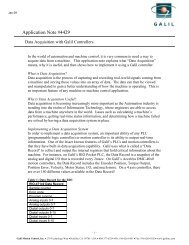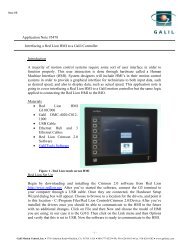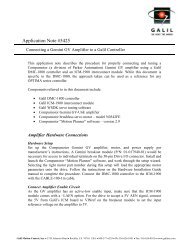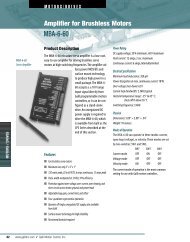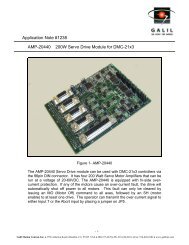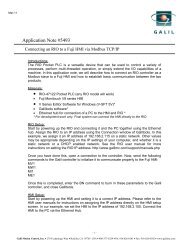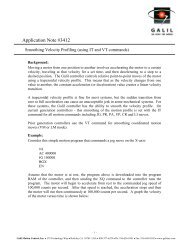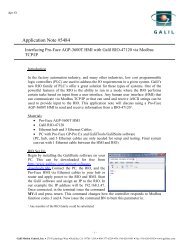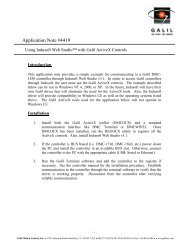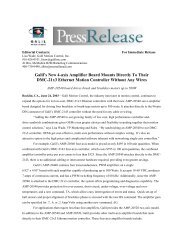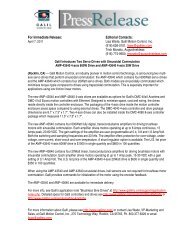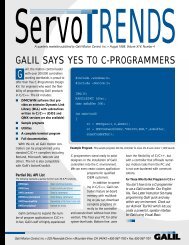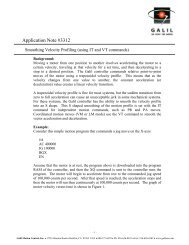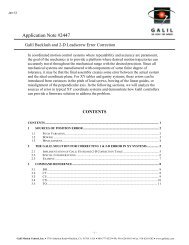Note 4434: Creating a Custom Ethernet Communication ... - Galil
Note 4434: Creating a Custom Ethernet Communication ... - Galil
Note 4434: Creating a Custom Ethernet Communication ... - Galil
You also want an ePaper? Increase the reach of your titles
YUMPU automatically turns print PDFs into web optimized ePapers that Google loves.
Jan-12<br />
Application <strong>Note</strong> #<strong>4434</strong><br />
<strong>Creating</strong> a <strong>Custom</strong> <strong>Ethernet</strong> <strong>Communication</strong> Interface to a <strong>Galil</strong> Controller<br />
For most applications, the standard <strong>Galil</strong>Tools communication libray or API (Application<br />
Programming Interface) provides the best method of communicating from either a<br />
Windows or Linux computer to a <strong>Galil</strong> controller. The <strong>Galil</strong>Tools communication library<br />
provides calls such as “Command()” and “ProgramDownload()” that provide a wrapper<br />
to make it easier for a programmer to get up and running in their language of choice (C#,<br />
C++, VB, LabVIEW, etc…). The <strong>Galil</strong>Tools communication library handles the lower<br />
level driver functions and communication protocols so that the programmer doesn’t have<br />
to. However, there are some situations in which it is necessary or required to<br />
communicate to a <strong>Galil</strong> controller without using the <strong>Galil</strong>Tools communication library.<br />
This application note will discuss what a user should be aware of when creating their own<br />
communication interface.<br />
Part I – Standard <strong>Communication</strong><br />
1) Opening a Socket<br />
Most programming languages that have an <strong>Ethernet</strong> interface have an “OpenSocket”<br />
type of function that will handle establishing the UDP or TCP/IP connection. The<br />
arguments will usually be the IP address of the device you are connecting to as well as<br />
a port number. For a standard connection to a <strong>Galil</strong> controller, the user should connect<br />
on port number 23 (Telnet). Other port numbers are allowed such as those above port<br />
1000 when needed for special applications. See the IK command for more info.<br />
2) Sending a Command<br />
Once a socket is established, the user will need to send a <strong>Galil</strong> command as a string to<br />
the controller (via the opened socket) followed by a Carriage return (0x0D).<br />
3) Receiving a Response<br />
The controller will respond to that command with a string. The response of the<br />
command depends on which command was sent. In general, if there is a response<br />
expected such as the “TP” Tell Position command, the response will be in the form of<br />
the expected value(s) followed by a Carriage return (0x0D), Line Feed (0x0A), and a<br />
Colon (:). If the command was rejected, the response will be just a question mark (?)<br />
and nothing else. If the command is not expected to return a value, the response will be<br />
just the Colon (:).<br />
- 1 -<br />
<strong>Galil</strong> Motion Control, Inc. � 270 Technology Way � Rocklin, CA 95765 USA � 800-377-6329 � Ph: 916-626-0101 � Fax: 916-626-0102 � www.galilmc.com
4) Closing the Socket<br />
The socket should be left open during general operation to send/receive commands. In<br />
order to close the connection, the programming language should have a “CloseSocket”<br />
that will close the TCP/IP connection to the controller.<br />
<strong>Note</strong>s:<br />
1) A single command should not exceed 80 characters, however multiple commands<br />
can be grouped together in a single packet by separating them with semicolons.<br />
2) Packet size should not exceed 450bytes<br />
3) See the Appendix of this document to see example pack ets of sending commands<br />
and receiving responses<br />
Part 2 – Advanced <strong>Communication</strong><br />
There are some cases where a second type of communication is necessary and the data<br />
from the controller is “unsolicited”. The two types of situations this occurs is:<br />
1. Data Record output from controller (DR command) over UDP. The Data<br />
Record is an internal block of information that can be output by the controller at<br />
a regular rate via a UDP handle. The structure for this block of data is specified<br />
in Chapter 3 of the controller’s User Manual. The size of the packet depends on<br />
the model of the controller and the number of axes. A dedicated UDP handle<br />
(socket) should be opened to the controller to receive these packets and process<br />
them. The DR command is used to specify the update rate and which handle to<br />
direct the Data Record packets to. See the Appendix for a sample DataRecord<br />
packet.<br />
2. Messages sent from a program executing on the controller. A program such as<br />
this:<br />
#A<br />
MG “Hello”<br />
WT100<br />
JP#A<br />
will output the message “Hello” every 100msec. The best way to receive these<br />
unsolicited messages is by opening a dedicated socket for them and directing<br />
the output via the CF command. There is a data adjustment bit (CW1) that can<br />
be set so that these messages have their most significant bit set high. This is a<br />
way that can be used to differentiate these messages from a standard command<br />
response and is especially useful if the unsolicited messages are sent out the<br />
same socket as the command responses (not recommended).<br />
3. EI Event Interrupts (Accelera controllers). The EI command allows the user to<br />
generate a UDP interrupt message with a specific status byte based on an<br />
interrupt condition. Some examples of interrupt conditions are a motion<br />
complete event, limit switch trigger, excess position error, digital input, or a<br />
user generated interrupt (UI). The complete list of events as well as the status<br />
byte value is shown in the Command Reference of the controller.<br />
- 2 -<br />
<strong>Galil</strong> Motion Control, Inc. � 270 Technology Way � Rocklin, CA 95765 USA � 800-377-6329 � Ph: 916-626-0101 � Fax: 916-626-0102 � www.galilmc.com
Appendix<br />
For more information on setting up the Controller <strong>Ethernet</strong> Network, see this article:<br />
http://www.galilmc.com/techtalk/motion-controllers/ethernet-network-guide-for-connecting-galil-controllers/<br />
The following sections shows the raw packets that are exchanged between the host and<br />
controller for informational purposes. In most cases, understanding the communication<br />
at the packet level is not necessary.<br />
Appendix A: Sending TP (Tell Position) from Host<br />
Packet Capture of sending TP\r<br />
Receiving Response from controller of position -46, 96<br />
- 3 -<br />
<strong>Galil</strong> Motion Control, Inc. � 270 Technology Way � Rocklin, CA 95765 USA � 800-377-6329 � Ph: 916-626-0101 � Fax: 916-626-0102 � www.galilmc.com
Appendix B: Initiating a Connection from host to controller (3 packets)<br />
The simplest example is when both devices already have a static IP address assigned. In<br />
the case shown here, the host has an IP address of 192.168.1.1 and the <strong>Galil</strong> controller<br />
has an IP address of 192.168.1.2. The following 3 packets show the sequence of the host<br />
requesting a connection (setting SYN=1), and then the controller acknowledging the<br />
request with a SYN=1 and ACK=1, and finally the host responding with an ACK=1.<br />
NOTE: This is part of the standard TCP/IP protocol – these packets should be generated<br />
automatically as part of the “OpenSocket” type of function provided by the programming<br />
languages TCP/IP socket interface. They are shown here for reference purposes only.<br />
- 4 -<br />
<strong>Galil</strong> Motion Control, Inc. � 270 Technology Way � Rocklin, CA 95765 USA � 800-377-6329 � Ph: 916-626-0101 � Fax: 916-626-0102 � www.galilmc.com
Appendix C : Data Record Packet on DMC-4020 (sent via UDP from controller)<br />
- 5 -<br />
<strong>Galil</strong> Motion Control, Inc. � 270 Technology Way � Rocklin, CA 95765 USA � 800-377-6329 � Ph: 916-626-0101 � Fax: 916-626-0102 � www.galilmc.com



